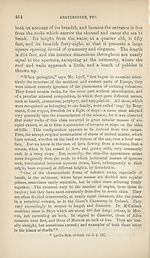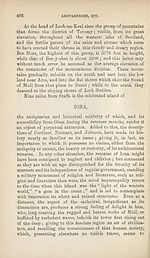Download files
Complete book:
Individual page:
Thumbnail gallery: Grid view | List view

STAFFA—MULL.
465
“In 1804 Mr. Gregoiy Watt showed, by his experiments on basalt,
that when, in the cooling of a molten mass of that rock, this structure
was developed, and two spheroids came into contact, no penetration
ensued, but the two bodies became mutually impressed and separated by
a plane well defined, and invested with a rusty colour, and he observed,
when several spheroids met, that they formed prisms. ... Of the inter¬
mixture of conditions producing flows of melted rock at one time from
the same general vent, or system of vents which should take the pris¬
matic form, and at another exhibit no tendency to that structure, the
Giant’s Causeway and adjacent district in the north of Ireland will
afford the observer a good example. The same mixture of prismatic
and more solid basalt is also to be found in the island of Staffa, where
the action of the Atlantic breakers has worn out the celebrated Fingal’s
The rock of Staffa consists of three distinct beds of trap of different
characters. The lowest is conglomerate, called trap tuff, the next is the
great columnar range, and the uppermost is an irregular mixture of
small implicated and bent columns with an amorphous basalt. These
beds dip towards the east. On the western side of the island, the order
and continuity of the beds disappear, and are replaced by a confused
mixture of the different varieties of trap. As minerals, the rocks and
foreign substances found in Staffa present hut little that is interesting.
The island of Mull, of which a good view is afforded as we
proceed onwards to Iona, is of very irregular form, being deeply
indented in the west by Loch-na-Keal, and projecting towards
the south-west into a long promontory called the Ross. Its
extreme length, which is at the southern side, is about thirty
miles, and its next most considerable dimension from south¬
east to north-west is about twenty-five.
Any picturesque features that exist are confined to the
shores ; in the interior of the country they never occur.
The promontories and columnar ranges at Loch-na-Keal and
in the sound of Ulva are striking objects, which sometimes
present the appearance of ruined walls of ancient castles. The
promontory of Gribon, one of the principal of these, consists
for the greater part of trap terraces disposed in a scalar man¬
ner ; but ascending to not much less than 2000 feet. The
whole coast here is bounded by high cliffs with steep slopes,
attaining an elevation of at least 1000 feet. In this part of
the island is Mackinnon’s Cave, which Dr. Johnson visited in
1773, under the guidance of Sir Allan Maclean.
* Geological Observer, by Sir Henry T. Delabeche, C.B. etc. chap. xx.
465
“In 1804 Mr. Gregoiy Watt showed, by his experiments on basalt,
that when, in the cooling of a molten mass of that rock, this structure
was developed, and two spheroids came into contact, no penetration
ensued, but the two bodies became mutually impressed and separated by
a plane well defined, and invested with a rusty colour, and he observed,
when several spheroids met, that they formed prisms. ... Of the inter¬
mixture of conditions producing flows of melted rock at one time from
the same general vent, or system of vents which should take the pris¬
matic form, and at another exhibit no tendency to that structure, the
Giant’s Causeway and adjacent district in the north of Ireland will
afford the observer a good example. The same mixture of prismatic
and more solid basalt is also to be found in the island of Staffa, where
the action of the Atlantic breakers has worn out the celebrated Fingal’s
The rock of Staffa consists of three distinct beds of trap of different
characters. The lowest is conglomerate, called trap tuff, the next is the
great columnar range, and the uppermost is an irregular mixture of
small implicated and bent columns with an amorphous basalt. These
beds dip towards the east. On the western side of the island, the order
and continuity of the beds disappear, and are replaced by a confused
mixture of the different varieties of trap. As minerals, the rocks and
foreign substances found in Staffa present hut little that is interesting.
The island of Mull, of which a good view is afforded as we
proceed onwards to Iona, is of very irregular form, being deeply
indented in the west by Loch-na-Keal, and projecting towards
the south-west into a long promontory called the Ross. Its
extreme length, which is at the southern side, is about thirty
miles, and its next most considerable dimension from south¬
east to north-west is about twenty-five.
Any picturesque features that exist are confined to the
shores ; in the interior of the country they never occur.
The promontories and columnar ranges at Loch-na-Keal and
in the sound of Ulva are striking objects, which sometimes
present the appearance of ruined walls of ancient castles. The
promontory of Gribon, one of the principal of these, consists
for the greater part of trap terraces disposed in a scalar man¬
ner ; but ascending to not much less than 2000 feet. The
whole coast here is bounded by high cliffs with steep slopes,
attaining an elevation of at least 1000 feet. In this part of
the island is Mackinnon’s Cave, which Dr. Johnson visited in
1773, under the guidance of Sir Allan Maclean.
* Geological Observer, by Sir Henry T. Delabeche, C.B. etc. chap. xx.
Set display mode to:
![]() Universal Viewer |
Universal Viewer | ![]() Mirador |
Large image | Transcription
Mirador |
Large image | Transcription
| Antiquarian books of Scotland > Scotland/Scots > Black's picturesque tourist of Scotland > (585) |
|---|
| Permanent URL | https://digital.nls.uk/130035210 |
|---|
| Description | Thousands of printed books from the Antiquarian Books of Scotland collection which dates from 1641 to the 1980s. The collection consists of 14,800 books which were published in Scotland or have a Scottish connection, e.g. through the author, printer or owner. Subjects covered include sport, education, diseases, adventure, occupations, Jacobites, politics and religion. Among the 29 languages represented are English, Gaelic, Italian, French, Russian and Swedish. |
|---|

